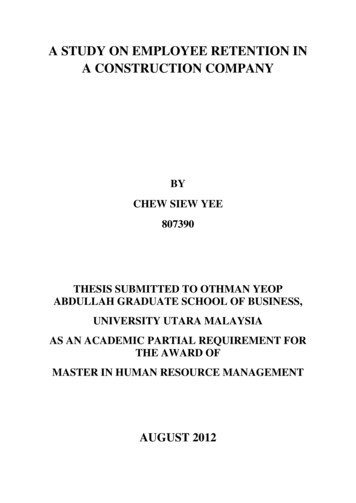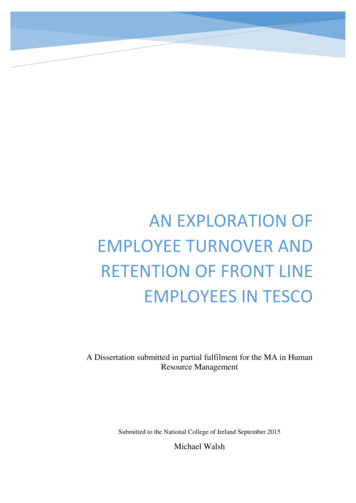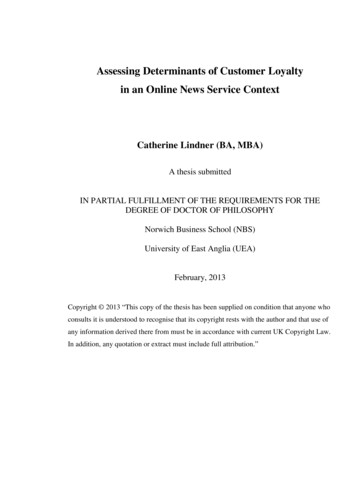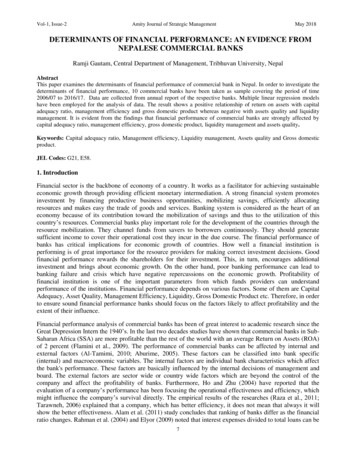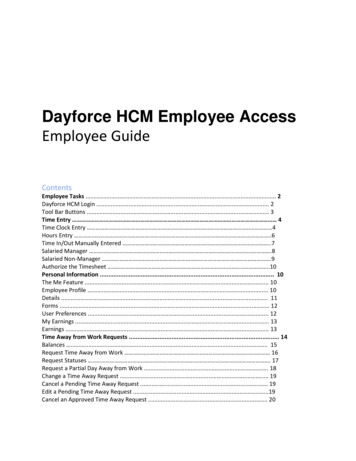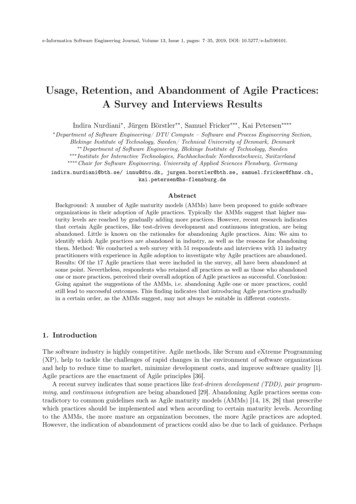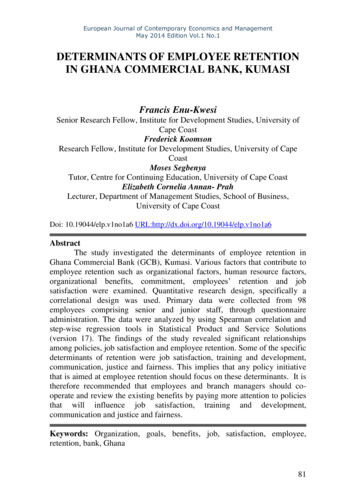
Transcription
European Journal of Contemporary Economics and ManagementMay 2014 Edition Vol.1 No.1DETERMINANTS OF EMPLOYEE RETENTIONIN GHANA COMMERCIAL BANK, KUMASIFrancis Enu-KwesiSenior Research Fellow, Institute for Development Studies, University ofCape CoastFrederick KoomsonResearch Fellow, Institute for Development Studies, University of CapeCoastMoses SegbenyaTutor, Centre for Continuing Education, University of Cape CoastElizabeth Cornelia Annan- PrahLecturer, Department of Management Studies, School of Business,University of Cape CoastDoi: 10.19044/elp.v1no1a6 The study investigated the determinants of employee retention inGhana Commercial Bank (GCB), Kumasi. Various factors that contribute toemployee retention such as organizational factors, human resource factors,organizational benefits, commitment, employees’ retention and jobsatisfaction were examined. Quantitative research design, specifically acorrelational design was used. Primary data were collected from 98employees comprising senior and junior staff, through questionnaireadministration. The data were analyzed by using Spearman correlation andstep-wise regression tools in Statistical Product and Service Solutions(version 17). The findings of the study revealed significant relationshipsamong policies, job satisfaction and employee retention. Some of the specificdeterminants of retention were job satisfaction, training and development,communication, justice and fairness. This implies that any policy initiativethat is aimed at employee retention should focus on these determinants. It istherefore recommended that employees and branch managers should cooperate and review the existing benefits by paying more attention to policiesthat will influence job satisfaction, training and development,communication and justice and fairness.Keywords: Organization, goals, benefits, job, satisfaction, employee,retention, bank, Ghana81
European Journal of Contemporary Economics and ManagementMay 2014 Edition Vol.1 No.1IntroductionEmployee retention, from its inception, has been well emphasized inPrice and Mueller’s (1986) model on retention (Bruce, 2003). This theoryseems to suggest that retention efforts by management must take intoconsideration employees’ higher needs in addition to their job context needs.This is also in line with Herzberg’s (1959) two factor motivational theorywhich classified employee’s needs as intrinsic and extrinsic needs (Mullins,2010).Employee retention became very important in the 1970s, when therewas a rise in the formation of small and medium-size businesses ascompetitive employers which provided viable employment opportunities inthose times (Coff, 1997). This led to the ascendancy in job mobility andvoluntary job changes, and organizations began to feel the impact of the riseof voluntary employee turnover. Additionally, the power in the paternalistic“status quo” employer-employee relationship was also shifting from theemployer to the employee, so a matching management tool began to bedeveloped which was employee retention (Connel & Philip, 2002).In this earliest, simplest form, employee retention was astraightforward response to how employers can stem the flow. The first stepsin employee retention were simply just some attempts to make the existingrelationship better and more pleasant for the employee by dealing primarilywith compensation, benefits, and the physical aspects of the workingenvironment (Allan & Sienko, 1997). Allan and Sienko also stated that bythe late 1980s and early 1990s, there was a growing realisation on the part ofboth employers and employees that there was more to employee retentionthan hygiene factors. Since then, employers have been paying attention toother needs of employees such as organizational factors, human resourcefactors, benefit factors, job satisfaction and commitment as a way ofensuring high employee retention in their organizations (Woodruffe, 1999).Organizations recruit human resources and train them to fit into theirset-ups. They therefore go to great lengths to ensure that recruited employeesare retained, by considering organizational factors, job satisfaction factors,human resource factors and employees’ benefits to meet the needs of theiremployees (Cheng, 2004). This approach is necessitated by the fact thatorganizations that are unable to retain their employees have to spend lots ofmoney and other resources to attract, recruit and train new employees whichmakes recruiting new employees more expensive than retaining the existingones (Jackson & Mathis, 2006). Such instability can lead to loss of marketshare and profit for these organizations, including those in the financialsector of any economy.82
European Journal of Contemporary Economics and ManagementMay 2014 Edition Vol.1 No.1The key players in a financial system include banks, non-bankfinancial institutions, brokerage houses, insurance companies, and regulatoryinstitutions. Borrowers, lenders, intermediaries and regulatory institutionslike the Bank of Ghana depend on the smooth running of the system, and theeffectiveness of this system largely depends on recruitment and retention ofcompetent employees (Dovlo, 2003). According to Dovlo, employeeretention is an important issue in both the public and the private sectors inGhana (Dovlo, 2003). In Ghana, the introduction of the Banking Act, 2007(Act 673) has brought about stiff competition among the commercial banks,including Ghana Commercial Bank (GCB), which is one of the largest, if notthe largest bank, in the country (Amidu, Hinson & Mensah, 2006).GCB offers important services such as maintenance of individual andcorporate savings and current accounts, commercial and corporate lending,corporate advisory services and international trade financing. Therefore,failure of GCB as part of the system can have severe ramifications on theGhanaian economy and the financial sector as well as on other employers.Despite, several attempts made by the GCB to retain its workersthrough provision of training, development and rewards among others, thebank still lost 4.3 percent of its market share in the year 2010(PricewaterhouseCoopers, 2010). However, there was no empirical study onwhether the cause could be due to employee retention issues.Several studies have been carried out on employee retention indeveloping countries. In Ghana, such studies have tended to focus on healthworkers and teaching staff (Dovlo, 2003). The various studies on employeeretention in the developed countries dwell on organizational factors, jobsatisfaction and human resource factors (Cheng, 2004). Thus, there isinadequate empirical evidence on how organizational factors, humanresource factors, job satisfaction and organizational benefits can influenceemployee retention. This paper therefore sought to examine how thesefactors contribute to employee retention in Ghana Commercial Bank,Kumasi.The rest of the paper comprises theoretical and conceptualdiscussions on employee retention and the methodology of the study. Theseare followed by discussion of the results. The final section of the paperprovides conclusion and policy implications or options.Theoretical and conceptual discussions on factors that affect employeeretentionSeveral factors, notably organizational, human resource, jobsatisfaction and commitment have been identified as explanatory variablesfor employee retention. These were captured in Price and Mueller’s (1986)revised turnover model which encompassed many of the earlier retention83
European Journal of Contemporary Economics and ManagementMay 2014 Edition Vol.1 No.1factors while introducing several new ones. The model compriseddeterminants such as job satisfaction, distributive justice and perceivedalternatives, considered as immediate causes of decisions to stay, whereaspay, promotional opportunities, constituent attachments, kinship, andorganizational commitment were included as not having direct influences.Griffeth and Hom (2000) affirmed that Price and Mueller’s model was basedon a thorough methodology, hence its acceptance in explaining turnoverprocesses.According to Mitchell (2002), recruitment and development ofemployees costs organizations a lot of resources in terms of training anddevelopment that are aimed at equipping employees with the necessaryskills, knowledge and competence to perform their current and future workassignment and challenges. Consequently, Jackson and Mathis (2006)propose that employers should strategically direct their efforts atunderstanding factors that influence retention and take measures to ensurethat employees remain with their organizations. This view is corroborated byHausknecht, Julianne and Vance (2008) who suggested that concerted effortis required to retain talented employees. Hausknecht et al. however, cautionthat there is a limit to what any organization can because retention is acomplex matter that is affected by internal and external factors, and thatthese external factors may be beyond the organization’s control. They advisethat organizations can try to manage the company's climate, culture, andquality of work life to enable employees stay with the organisation.Organizational factors and employee retentionOrganizational factors are leadership style, company policies,company culture, communication and organizational justice. While Bryman(1992) showed that managers in high turnover organizations believe thatemployees are not to be trusted, several research findings indicate thattransformational and charismatic leadership styles result in a high level offollower motivation and commitment as well as well-above-averageorganizational performance and attainment of organizational goals (Nanus,1992; Steyrer, 1998). According to Olorunjuwon (2008), people often seekemployment in a particular company because of its culture. However, whenthe culture changes, some employees become uncomfortable and leave,especially when such changes are not communicated effectively.Communication as a component of organizational factors is importantto employee retention and employers need to communicate theorganizational goals, policies, visions, strategies and the job requirements toemployees (Becker & Gopinath, 2000). Becker and Gopinath emphasizedthat communication helps to increase employees’ level of consent,84
European Journal of Contemporary Economics and ManagementMay 2014 Edition Vol.1 No.1participation, motivation, identification and building of trust, which inessence introduces elements of justice within the organization.Greenberg (1987) argues that the major dimensions of organizationaljustice are distributive, interpersonal, informational and procedural andemployees’ perceptions of justice or injustice within the organization canresult in a myriad of outcomes both positive and negative. Outcomes areaffected by perceptions of organizational justice as a whole or by differentfactors of organizational justice (Kreik, Muchinsky & Schreuder, 2002).Human resource factors and employee retentionThe human resource department’s effort to retain the best personnelbegins with recruitment. Taylor and Cosenza (1997) suggest that employersmust be candid about the prevailing extrinsic factors and other details duringrecruitment to reduce the chances of making hiring mistakes and minimizeturnover. Armstrong and Murlis (2007) also stated that an organisation’sextrinsic reward system can significantly affect the performance of theemployees and their desire to remain employed though money alone is not aretention factor.For instance, Thomas and Eaglen (2000) reported that low levels oftraining give rise to high levels of employee turnover and that the provisionof good training has a positive effect on employee retention. Hunt, Osbornand Schermerhorn (2003) also argued that a good strategy for organizationsto improve workforce productivity radically, increase job satisfaction andcommitment, and enhance retention is to seek to optimise their workforcethrough comprehensive training and development programs to ensureacquisition of requisite skills and competencies (Cheng, 2004; Cordero,2011).Job satisfaction, organizational benefits, commitment and employeeretentionAccording to Bruce (2003), the theory of organizational equilibriumsupports the view that job satisfaction plays a mediating role between selfimage, job relationship, and retention. Employee satisfaction is therefore afunction of a comparison between the outcomes or rewards received and thecontributions put toward the job. Intrinsic factors such as employees'opportunity for personal achievement, recognition from supervisors andgrowth are related to job satisfaction, while extrinsic factors such ascompany policy, administration, supervision, and working conditions areassociated with job dissatisfaction (Robbins, 2001).Beech and Tompkins (2002) explain that benefits are indirect rewardsgiven to an employee or group of employees for organizational membership,and these can be categorized into two broad areas such as mandated and85
European Journal of Contemporary Economics and ManagementMay 2014 Edition Vol.1 No.1voluntary benefits. According to them, the relative importance of benefitswill vary according to the specific needs of each individual, and this, inCordero’s (2011) view, can influence commitment and consequentlyretention.Organizational commitment, according to Allen and Meyer (1990), isthe extent to which people accept and internalize the goals of an organizationand view their organizational role in terms of its contribution to those goals.Hitherto this, Mowday, Porter and Steers (1979) had explained thatorganizational commitment focuses on attachment to the organisation, whilejob satisfaction emphasised the specific task environment where duties areperformed. Price and Mueller (1981) subsequently built upon these ideas andproposed a two-factor model of commitment and stated that employeecommitment acts to media
employee retention such as organizational factors, human resource factors, organizational benefits, commitment, employees’ retention and job satisfaction were examined. Quantitative research design, specifically a correlational design was used. Primary data were collected from 98 employees comprising senior and junior staff, through questionnaire administration. The data were analyzed by .


